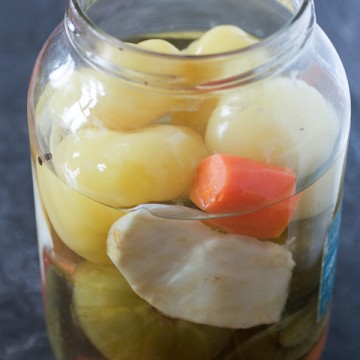
A Guide To Fermenting Veggies For Salad aka Turšija
Ingredients
- 2 gallons water
- 8.5 cups vinegar
- 12 ounces table salt
- 9 ounces white sugar
- 4 tablespoons peppercorn
- 1 tablespoon potassium sorbate powder
- 1 tablespoon citric acid powder
- Optional 2 tablespoons dill
- 4.5 pounds yellow bell pepper shaped tomatoes
- 2 pounds green tomatoes
- 2.5 pounds small cucumbers
- 4.5 pounds cauliflower
- 4.5 pounds carrots
- 3 pounds shallots
- 4.5 pounds cabbage heads
- 1 celery root
- 1 5- gallon plastic container tub or a bucket with a lid, or a few larger glass jars
Instructions
- In a large pan, combine water, vinegar, salt, sugar, peppercorn, potassium sorbate and citric acid powders. Mix well until all ingredients are dissolved in water.
- Wash all vegetables thoroughly, and dry them. Cut up cabbage into quarters. Break cauliflower into several florets. Chop up the celery root. Cut carrots in half.
- Take the fermenting container (or jars) and layer the vegetables inside. Start with a level of yellow bell pepper tomatoes, followed by the green tomatoes, followed by cucumbers, etc. Once the container is full, push down really well, and add more vegetables in if possible. The vegetables should be squeezed together tightly.
- Pour the water from step 1 into the container, as much as of it as it will fit, making sure everything is well covered with water. You may have more water and vegetables left over at the end. Feel free to use another smaller container or a jar and repeat the process.
- Close the containers tightly. Transfer to a dry place, and leave covered for at least 15-20 days. After that period your vegetables will be fermented and ready for consumption. They last several weeks to months. Feel free to transfer some of the vegetables into a smaller container and keep it in the fridge once you are ready to consume them.
Notes
You can easily halve the recipe if this volume is too much.
Once they start getting a really sour taste, discard them. This won't happen for quite a while though.
Once they start getting a really sour taste, discard them. This won't happen for quite a while though.
Tried this recipe?Let us know how it was!